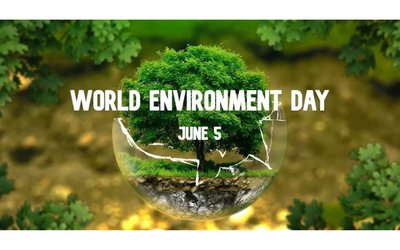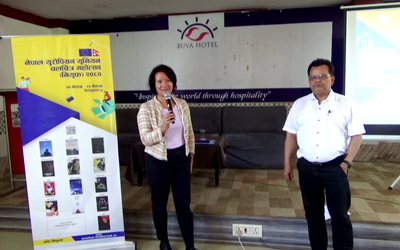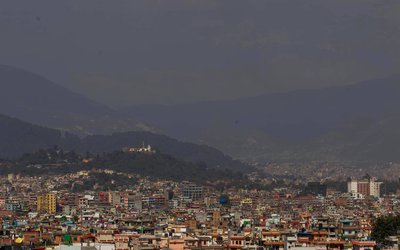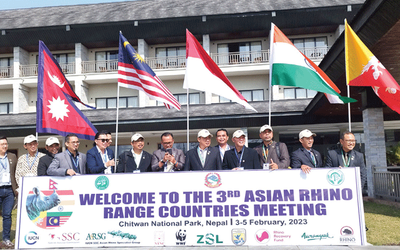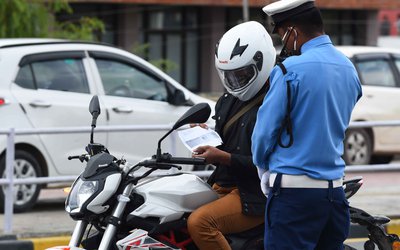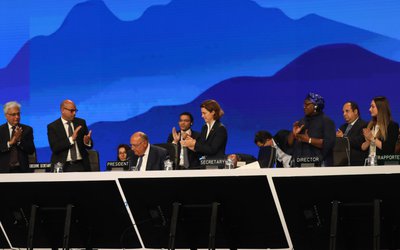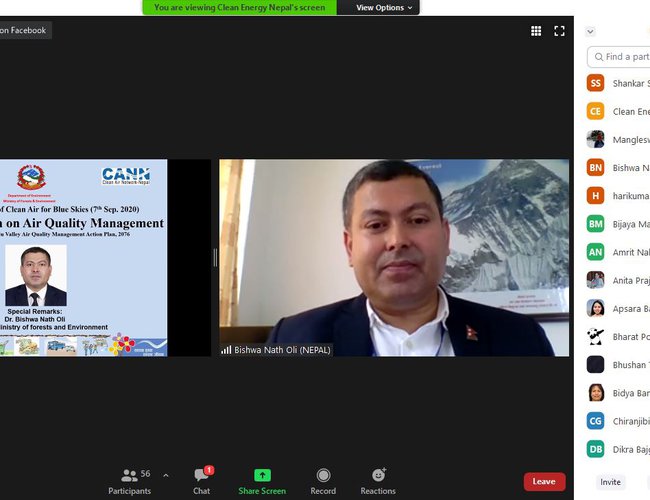
Dr. Bishwa Nath Oli, Secretary of the Ministry of Forests and Environment (MoFE), said that the Ministry has been taking several efforts to control the air pollution in Kathmandu valley.
Addressing a panel discussion on Air Quality Management, secretary Dr. Oli said that the ministry will implement all necessary programs to control air population through Environment Act and regulations.
On the occasion of International Day of Clean Air for Blue Skies, Clean Energy Nepal together with the Department of Environment (DoE), Ministry of Forests and Environment (MoFE) and Clean Air Network Nepal (CANN) organized a “Panel Discussion on Air Quality Management” focusing on Kathmandu Valley Air Quality Management Action Plan, 2076.
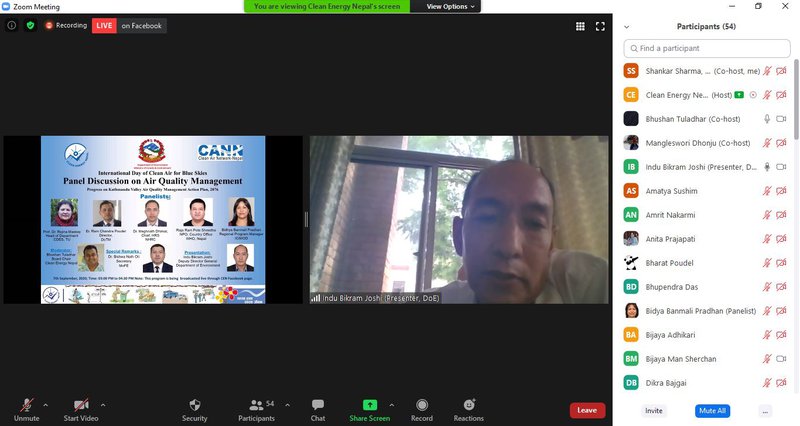
The main objective of this program was to bring all the stakeholders working on air quality regime and to discuss the present context of air quality issues specific to Kathmandu Valley and raise a common understanding for the effective implementation of the Air Quality Management Action Plan for Kathmandu Valley.
The discussion program was moderated by Bhushan Tuladhar, Board Chair of CEN. Dr. Bishwa Nath Oli, Secretary of the Ministry of Forests and Environment (MoFE) shared his opening remark in the program.
The panelists for the program were; Prof. Dr. Rejina Maskey from the Central Department of Environmental Science (CDES), TU, Er. Ram Chandra Poudel from Department of Transport Management (DoTM), Dr. Megnath Dhimal from Nepal Health Research Council (NHRC), Raja Ram Pote Shrestha from World Health Organization (WHO) Nepal, Country Office, Bidhya Banmali Pradhan from International Center for Integrated Mountain Development (ICIMOD).
Indu Bikram Joshi, Deputy Director-General and Keshab Joshi, Environment Inspector of Department of Environment (DoE) jointly delivered an overview presentation on Kathmandu Valley Air Quality Management Plan in the program. “The aim, objectives, and activities listed in the action plan are very positive, comprehensive, and doable.
The role of academic institutions has been highlighted in the AQM Action Plan, however, it can be further strengthened as Universities are key agencies generating knowledge and also plays a significant contribution to research, knowledge management and monitoring and evaluation” said Prof. Dr. Rejina Maskey.
Er. Ram Chandra Poudel said that the effective implementation of available policies on vehicular emission is very urgent as research shows that the emission rate in Nepal is beyond the vehicle emission standard set by the Government.
He also added that technical capacity strengthening is crucial. “Vehicle fitness test centers are being operated in cities like Kathmandu, Hetauda and Butwal but the Department plans to implement this in every province. Mass emission measurement lab or real-time emission measurement lab is also needed to monitor air pollution from the transport sector” informed Poudel.
Dr. Meghnath Dhimal said the global health an
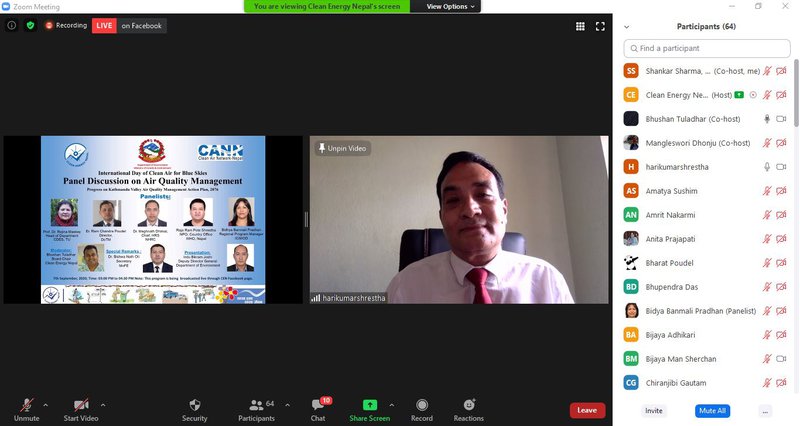
d economic impact of air pollution is clearly evident however we should further focus on the generation of databases and increase work on health researches in Nepal. “Air pollution needs to be taken seriously. The annual mortality rate due to air pollution in Nepal is 37,000 which means that air pollution causes about 100 deaths per day which is far more than the COVID virus when compared.
The four major sources of air pollution identified by the Urban Health Initiative (UHI) which is a pilot program initiated by WHO; are solid waste open burning, transport, industry/brick kilns, and household energy sectors" said Raja Ram Pote Shrestha.
Bidhya Banmali Pradhan said that the action plan is comprehensive and welcoming as it includes all stakeholders. “It takes millions to convert traditional brick kilns into cleaner kiln technologies and to relocate such kilns after conversion seems a little futile. Therefore, we need to revise this part of the action plan” she highlighted. Hari Kumar Shrestha, Kathmandu Metropolitan City (KMC) and Nistha Joshi, Lalitpur Metropolitan City (LMC) shared the efforts of each Metropolitan cities contributing to air pollution minimization.
Bhushan Tualdhar concluded that the implementation and coordination committee should be formed as soon as possible and effective implementation of the action plan needs to be taken forward for better air quality management of Kathmandu valley. Around 150 participants from governmental agencies, non- governmental agencies, academia, transport entrepreneurs, urban/transport planners, research institutions and media joined the virtual discussion program via zoom and Facebook live stream.
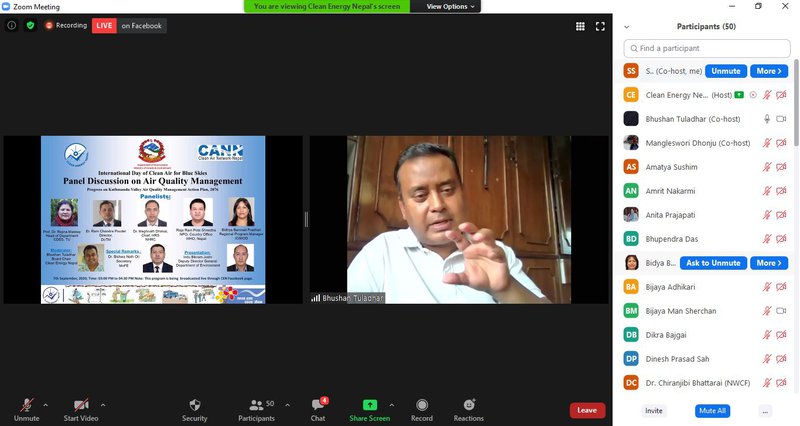
- Ambassador Subedi Presented The Letter Of Credence To President Of Italy
- Apr 25, 2024
- Nepal-Qatar Joint Business Council Formed
- Apr 25, 2024
- Weather Forecast: Isolated Brief Rain Is Likely To Occur At Few Places Of Koshi, Sudurpaschim And Karnali
- Apr 25, 2024
- Qatar And Nepal Ink Several MoUs, Returned Home Completing Two Days Visit
- Apr 24, 2024
- Russia Industrialists Met Prime Minister Dahal
- Apr 24, 2024

